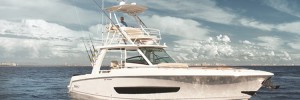 Marine Concepts turned to Composites Consulting Group (CCG) and DIAB for material and construction assistance when asked for a new design mould for the Boston Whaler.
Marine Concepts turned to Composites Consulting Group (CCG) and DIAB for material and construction assistance when asked for a new design mould for the Boston Whaler.
DIAB explains, when constructing something as large as a boat, you need a mould to shape and support the materials until they solidify. So to build one fibreglass boat, you must in fact build two boats: the finished product and the mould from which it springs.
It explains, with a female mould, you normally build three boats to get one: first a male plug on which the female mould is formed, then the mould, and finally the boat itself. The larger the boat, the heavier the mould will be. That is why many boat builders are turning to composite materials for their moulds and tooling. Composite moulds also have the advantage of being very durable.
Composite construction is far from novelty for Florida-based Marine Concepts. With more than 30 years of experience in plug and mould building, the company says it has a reputation for quality, performance and integrity.
When contacted by Boston Whaler about a challenging new mould design, Marine Concepts says it turned for help with the infusion process to Composites Consulting Group (CGG), with whom they had worked with before.
Chris Wachowski, Boston Whaler’s Director of Product Development, adds one of the main drivers for creating the fibreglass hybrid tooling was to overcome facility constraints for hoisting heavier moulds, as the size of our product has grown to 42ft.
The company explains that the main challenge was to complete the project in the required time frame. There was a large amount of material to handle. The hull mould required 8 plies of glass fibre reinforcement and 2 layers of 25 mm thick core material. The liner mould required the same amount of laminate and one single layer of core, but its geometry was very challenging, which made construction and infusion difficult.
The build specifications were already in place and fast and efficient material delivery was crucial for the project, continues Dean Callander. Marine Concepts opted for Divinycell H200 and ProBalsa due to DIAB’s ability to get the team what they needed in the compressed time frame.
Dean Callander worked with Marine Concepts at their premises through most of the construction process, including manifolding and infusion. Assisting him was Belle Blanding, who created the infusion manifold and utilised computer flow modelling to optimise the design from CCG’s office in Dallas, Texas, US. Assisting Marine Concepts onsite was also Sam Casto, South East Regional Sales Manager at DIAB.


